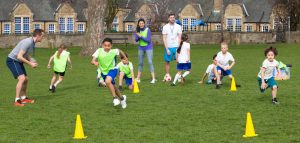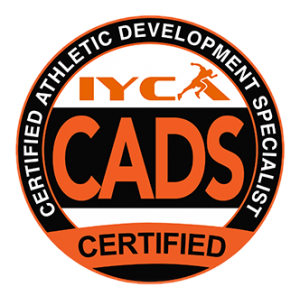Working with children at any age is an art as well as a science. As coaches, we aim to push our young athletes out of their comfort zone so they can grow physically and mentally within their sport and beyond. Science continues to provide methods by which we can do this effectively. However, we must also find ways make the process enjoyable and engaging for the kids involved.
Many of us remember the “lines, laps, and lectures” that marred our experience with youth sports. We also remember that special coach or training environment that brought out the best in us. This situation was usually created by coaches who understood the inner workings of children in the development process. They acknowledged the role of pushing our limits, but also created an environment that was positive and engaging. And yes, FUN!
The “conditioning” aspect of training is probably the least popular amongst athletes at any age. However, it’s a necessary evil when it comes to physically and mentally preparing youngsters for competition. Fortunately, conditioning does not have to be a Bear-Bryant-esque death march. By using gamification, creativity, and just plain old fun, it can be a tool to keep kids smiling while they sweat.
Consider combining the specific conditioning protocols you use for your individuals and teams with the more engaging, gamified versions below. Watch how the context of play brings out higher levels of effort and resilience, both indicators of high performance!
Letter Agility
This activity is ideal for individuals and teams when space is limited.
- Spread athletes in the space, providing ample room around each to move.
- Call out a letter, and they have to re-create that letter on the ground by moving their body in the specific pathway as fast as possible.
- The letters should cover roughly a 6-foot area.
- Progress from letters to words and/or shapes.
- Provide time constraints.
- Have them face a partner and race.
Dirty and Clean
This is a great activity for large spaces and teams.
- Randomly place cones throughout a large area. The larger the area, the greater the distance each athlete must cover to play the game.
- Assign one team to be the “dirty” team, the other the “clean” team.
- Prior to beginning, make sure to have a count of how many cones are being used.
- On the whistle, the “dirty” team must disperse and continue to knock over as many cones as possible with their hands.
- The “clean” team must set the cones back up as fast as possible.
- Athletes must move throughout the space. Neither team can knock down or set up the same cone two times in a row.
- At the end of the time (20-30 seconds) whoever has the most cones either knocked over or standing is the winner.
- Repeat, switching roles.
- For added challenge, change the body parts that can be used to knock over cones.
Compass Calisthenics
This simple concept is great for individuals and teams when space is limited.
- Create a list of 10 bodyweight exercises that can be done in place.
- Familiarize the athletes with the compass directions (East, West, North, South).
- Athletes perform each exercise for 30 seconds.
- During this time, the coach will frequently call out one of the compass directions and the athlete has to re-orient their body and movement to that direction. For example, “Push-ups EAST, NORTH, WEST”, etc.
- 10 Seconds of rest is provided between exercises.
Human Cone Drill (Jumping Jacks)
This is great competitive activity for moderate to large spaces and teams.
- Split athletes into teams of 5.
- Set up cones for each team, separating each by roughly 10 yards.
- Have teams stand in line behind a cone, facing a corresponding cone roughly 30 yards away (distance can be shortened for different ages, and training spaces).
- Athletes stand in a single file line with arms outstretched onto the person’s shoulders in front of them.
- On the whistle, athletes begin doing jumping jacks.
- On a second whistle, the athlete in the back of the line must weave through their teammates while avoiding the jumping jack arms.
- Once a teammate has moved to the front of the line, they can call “go” and the next person in the back of the line weaves through.
- The goal is for a team to reach their distant cone before the other teams.
- When the coach blows a whistle during the race, the last person in line must stop and put their hands out in front of them.
- The entire line must re-form so all participants can place their hands on the shoulders in front of them.
- When all teams have accomplished this, the whistle is blown again and competition continues.
Partner Mirror Drill
This is a conditioning activity for partners when space is limited, or when reaction speed is a goal.
- Create partners.
- Partners decide who the “leader” and who the “follower” will be.
- On the whistle, the leader begins to perform activities of their own choosing, i.e. shuffling, jumping, calisthenics, etc.
- Instruct athletes to use a relatively small 6-8-foot area for movement.
- The follower must try to mirror exactly what the leader is doing in real time.
- On the coach’s whistle, the roles switch.
- Continue for 30 second intervals.
- Encourage creative, varied movement, i.e. dance moves, calisthenics-to-locomotion, etc.
- To increase difficulty, a movement cannot be repeated while someone is a leader.
All of the activities above function to challenge the metabolic system. However, by gamifying the experience, kids actually enjoy the process. The more the enjoyment, the greater the effort.
Integrate these fun and challenging conditioning activities into your youth programs and beyond. Never be afraid to create an environment where athletes smile while they sweat.
 Brett Klika is a youth performance expert and a regular contributor to the IYCA who is passionate about coaching young athletes. He is the creator of the SPIDERfit Kids youth training program and has run successful youth fitness programs all over the country. Brett is an international speaker whose passion for youth fitness has helped thousands of people learn how to create exceptional training experiences for young athletes.
Brett Klika is a youth performance expert and a regular contributor to the IYCA who is passionate about coaching young athletes. He is the creator of the SPIDERfit Kids youth training program and has run successful youth fitness programs all over the country. Brett is an international speaker whose passion for youth fitness has helped thousands of people learn how to create exceptional training experiences for young athletes.
The IYCA Certified Athletic Development Specialist is the gold-standard certification for anyone working with athletes 6-18 years old. The course materials were created by some of the most experienced and knowledgeable professionals in the industry, and the content is indisputably the most comprehensive of any certification related to athletic development. Learn more about the CADS certification here:


